Memories Of South Milwaukee
Help us preserve and celebrate our heritage for future generations by sending your own memories to us at southmilwaukeehistory@gmail.com.
Shared by The Extended Gondek family
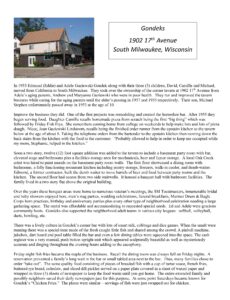
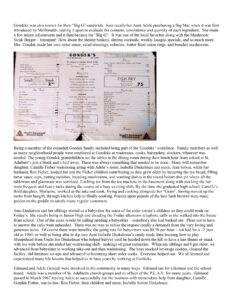
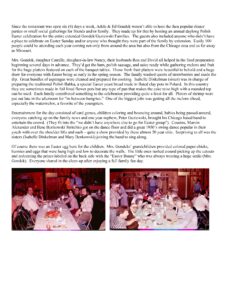
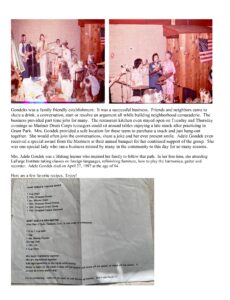
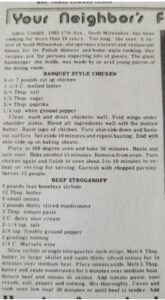
Shared by Lucille Grochowski
This was a handwritten note recently found in our Basket Factory file.
Lucille’s husband was named Frank and would have been 80 years old in 1993.
My husband was about 10 years old (he is 80 now) when he and his friends would go down to the basket factory to look in the open windows to see what was going on. He remembers seeing huge saws being run by pulleys. The logs were put through hot water troughs to remove the bark. Then the saws would cut them. Then they would go thru another cutting where they were sawed into thin pieces and put in hot water so they could be pliable to make the baskets. There was a lot of steam and noise as expected. When the boys were seen they were chased away so they wouldn’t get hurt. That’s all he can
remember.
Lucille’s husband was named Frank and would have been 80 years old in 1993.
My husband was about 10 years old (he is 80 now) when he and his friends would go down to the basket factory to look in the open windows to see what was going on. He remembers seeing huge saws being run by pulleys. The logs were put through hot water troughs to remove the bark. Then the saws would cut them. Then they would go thru another cutting where they were sawed into thin pieces and put in hot water so they could be pliable to make the baskets. There was a lot of steam and noise as expected. When the boys were seen they were chased away so they wouldn’t get hurt. That’s all he can
remember.
Shared by Herb Evert
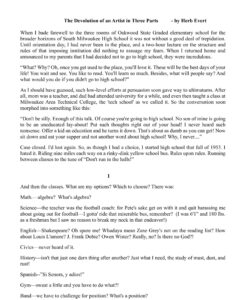
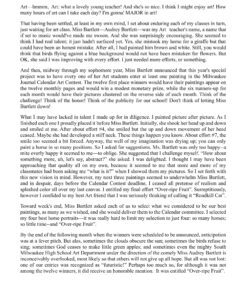

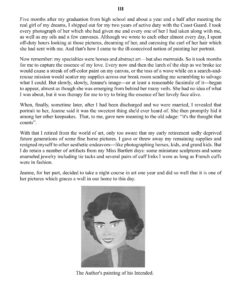
—
We hope you enjoyed the above story.
This passage was captured from Herb Evert’s book, A Break in the Clouds.
300 pages of short stories and anecdotes about the author’s boyhood and youth, military service, marriage and family, and life with his beloved field-bred English springer spaniels, all written with a touch of humor, love, and faith. A joyful book, and one to enjoy.
Shared by Sue Ziarek
This is a memory my mother, Helen Ziarek (nee Grochowski) shared with me a few years back. She grew up on 17th Avenue, just north of Rawson Ave. At the time (early 1920’s) it was known as Grand Boulevard north of Rawson Avenue because it had a wide grassy strip down the middle. One day, my grandmother sent my mother over to the neighbor’s house with a note telling them they should stop letting their cow graze in the middle of the boulevard!
Record Blizzard of 1947: Chuck Baumback
My recollection (from age 13) is that the storm dumped 24 to 28 inches in a day or two. (The internet says about 18” but the internet must be wrong.) The whole metropolitan area was paralyzed and it took South Milwaukee a day or two to get most streets minimally functional. Cudahy, Town of Lake (unincorporated then) and Milwaukee were slower—as much as a week before we could get to Milwaukee. As drifting and blowing snow overwhelmed puny human counter-efforts, trucks, autos and at least several buses got stuck and had to be abandoned. Everyone helped everyone. People were taken into homes for shelter and fed whenever there was need. Bus drivers, unable to get home were taken into private homes. But even when their buses were freed they couldn’t get to Milwaukee so they drove the usual routes within SM, over and over, maybe for 16 hours a day—and grew beards. I think paying bus fares was optional but I bet most were happy to do so. Formal stops and routes became a bit informal. Local fuel suppliers kept the busses going on credit (or maybe for free). Everyone supported and cheered those intrepid drivers and had their pictures taken with them. And their beards! Before those drivers were finally able to get back to Milwaukee I think they were able to get to Carrollville for awhile and even service that route. During the first night of the storm there was a big important power-failure at one of the factories in Carrollville and an electrician was needed. There were no ski-mobiles then and nothing was getting through anywhere. The snowdrifts were four to six feet deep! Luckily there was some military installation still there from WWII. Somehow they were able to send a tank down 5th Avenue to South Milwaukee, get an electrician and carry him back to Carrollville where he repaired the problems. I lived east of 5th Avenue up a long hill beyond the “Barrel Factory”. There the drifts were deepest. Having heard the tank story on the radio I went the next morning to 5th Av about a block west of our house. Without snowshoes the going was tough but somehow I got there. I expected to see a plowed lane, like the Seabees did in the Pacific to make roads and airfields with dozer blades attached to tanks. But no! Amazingly it looked like the tank floated on the top of the drifts and the tracks were less than a foot deep. At least that’s my memory—and it must be correct because I was so surprised that I inspected them carefully and predicted it would take weeks to dig that road out. When the road was opened later, just wide enough for two lanes, the side banks were straight vertical and at least head high with no way to escape if a car came and you were below the bank. For the rest of the winter we had to walk on the top of the bank at least to Marion Av where sidewalks and urban lots and houses started. It was particularly treacherous wherever someone had shoveled out an access to the side and pedestrians had to climb down and up again to proceed. Luckily there were only three or four places like that. And it was always a unique feeling to have cars whizzing by your side with their roofs near or even below our feet. I recall feeling a lot of pride that independent South Milwaukee was one of the first, maybe THE first city in the area to be plowed out and functional—not that it mattered much except locally since you couldn’t get to any other towns, including Milwaukee!
Shared by Mrs. Clara Wilkowski
On Sunday afternoon we got to go to the movies. Afterwards we’d stop at G&G ice cream store! They had a square shaped cone that held ½ a pint of ice cream. Mrs. Georgevitch would take the square pint and cut it diagonally so that it fit right in the cone. It cost 5¢!
Shared by Sue Ziarek
My brother and his friends used to go crabbing at the ‘crick’. Then they’d build a fire in the charcoal grill and boil them up. I was too chicken to even touch them but my brother peeled one for me to try insisting it tasted just like shrimp. The problem was I didn’t like shrimp!!
Shared by Sue Ziarek
In late June mom, dad, my brother and I would pile in the car and meet my aunt & uncle with their 4 kids at a pick-your-own strawberry farm (usually Perterka in Oak Creek—they gave you a discount if you brought your baskets from last year) where we’d spend hours picking berries in the hot sun. The trunks would be covered in heaped up strawberry baskets when we were done. As tired as we’d be when we got home, picking berries was just the start. Mom would fill the sink with water and wash the berries; my brother & I would be set to work at the kitchen table removing the hulls. Dad would get out the canning equipment. Jars would be set in boiling water on one back burner to sterilize them and there was a special small kettle mom used just to melt the canning wax on the other one. The berries and sugar would be carefully measured out into the big canning kettle that had been handed down from my grandmother. You had to stir the strawberries the whole time and the clouds of steam that bubbled out of it smelled so good! When they were boiling so hard you couldn’t make them stop mom would pour in the pectin and then dad would quickly transfer the kettle to the counter. First mom would skim the foam off the top into a small dish then gently fill the hot jars and finally spoon just enough wax on top to seal them. When the kettle was empty the process would start all over again because one batch just wasn’t enough to last all winter even though we also made grape & peach & crab apple! Strawberry seemed to be everyone’s favorite. When the last batch was finally done and the kitchen was all cleaned up mom would bring out that dish with the foamy jelly and a sleeve of soda crackers and we’d all sit at the kitchen table. That first bite made it all worthwhile because nothing can compare to homemade jam! As a final reward for all our hard work, we’d close up the house, turn on the window air conditioners, pile in the car and head to Hi-Ho The Dari-O for an ice cream cone while the house cooled down. Even our little dog Ginger got a baby cone!
Working at the basket factory by Harold W. Hein
Several of the firth and sixth graders at the new high school, now the Junior High, worked after school at the South Milwaukee Basket Factory. We wove the strips in and out of the ribs and would do either baskets by six o’clock, making five cents for each basket, for forty cents an afternoon. After we had woven the market basket, full-time workers there nailed on the top edge and attached the handles on the ends. One day I came to work and slapped Joe on the back causing him to swallow a mouthful of nails! The workers kept a mouthful of nails in the mouth and with a magnet hammer would touch the hammer to their lips attaching a nail which then was nailed into the wood basket rim. Joe chased me all over the shop. He was so mad and of course I felt terrible. I hardly slept that night but the next afternoon on getting to work I found Joe there working as usual.
PEACOCKS IN THE PARK: Chuck Baumbach
Until the summer of 1939, when I turned six, I lived at 604 Park Avenue, less than 200 feet from the main north entrance to Grant Park. As soon as the snow and muddy trails were passable, my farther took me on frequent walks down a ravine toward the lake and back. Starting at the park entrance, a narrow graveled trail declined eastward along a row of big hefty cages painted green. Inside were beautiful peacocks. It seemed they were always displaying their incredible huge multicolored tails—especially in spring. There were numerous modest brown females too, probably nesting, but one hardly noticed them. The displays seemed quite constant but in reality probably required a great deal of waiting, watching and coaxing by spectators. In any case, there were a constant lure to a pre-six year old to go and see them.
THE TOY LOAN CENTER: Chuck Baumbach
In the summer of 1939 we moved to 722 Monroe Ave, a giant house with three floors including an unfinished 12 foot high attic and a basement—complete with a coal-bin, a rain barrel (for shouting into) and a diagonal cellar door (for sliding down per the popular playmates song). After we moved I was allowed to get a red wagon. But it was still the Depression, people out of work and everyone very frugal, and who knew if a kid wanted something, or whether he would use and appreciate it after he got it. Well, necessity is the mother of invention. The W.P.A. (Works Progress Administration) had the answer: “The Toy Loan Center” located at the Fourth Ward School on Rawson Ave! In a small sheet-metal building the Toy Loan Center renovated old toys and lent them out like library books for a fixed period of time. Voila! I got a newly painted red wagon for the rest of the summer. And the center by itself was wonderful—and all free—every kind of doll (complete with newly glued hair and newly painted faces) and every sort of sports equipment and wondrous things that to a six year old had never been seen before—but an adult had to sign it out if you were under twelve I think.
Where Was Columbia Park—by Al Ladwig
When I was a young lad, my grandfather, Ed Ladwig used to come over to our house on Menomonee Avenue and reminisce about his boyhood in South Milwaukee. He was born in 1889, and he moved to South Milwaukee with his family in 1894. One of the things he talked about was playing football when he was young. Unfortunately I did not ask enough questions to get the full story. The recent digitization of the SM newspapers gave me the opportunity to do some research on the subject. Beginning in the fall of 1900 there are stories in the paper about the high school boys playing football at Columbia Park. Of course my grandfather was too young to be in high school in 1900, and he told me that he had dropped out of school after the third grade. An October 1904 story caught my interest. “The Rivals of South Milwaukee have organized for the season and won a game last Saturday 10-0. The Rivals line up as follows. Daniel Davis, fullback Newton Shepard, left halfback and captain Earl Ingalls, right halfback Harry Davis, right end and manager Larry Ward, left end “ Joe Brings, right tackle John Pederson, left tackle Ray Grover, right guard Ed Ladwig, left guard Loyd Clare, center The left guard was my grandfather, but, a subsequent story about the high school football team listed a different set of players. Thus I assume this story referred to a town team rather than the high school team. In 1907 this story appeared. “South Milwaukee’s first football for the season was played at the baseball park last Saturday afternoon. The local team was made up of a few of the high school boys and others picked up around town.” I would suspect he played in this game. The “baseball park” seems to refer to Columbia Park. This and several subsequent stories make a similar reference. So where was Columbia Park? After scouring the newspapers with no luck, I tried the SM Library where I had a similar disappointment. Finally I contacted the Milwaukee County Historical Society where I located a 1910 Sanborn Fire Map of South Milwaukee. Here is what I learned from the map. Columbia Mineral Wool Company moved to South Milwaukee in the 1890s and was located between 9th Avenue and the RR tracks a couple of blocks south of Marquette. Just north of the plant is an open field. When I was a young man, we called this baseball field Idlehour Park. Clearly this space was called Columbia Park and was used for baseball and football games in the early part of the 20th century. In the 1950s the first South Milwaukee Little League Park was built in this space. The South Milwaukee Public Library and the South Milwaukee Historical Society both now have copies of the 1910 Sanborn Maps if needed for research. Where Was Columbia Park—by Al Ladwig For those of you wondering…. 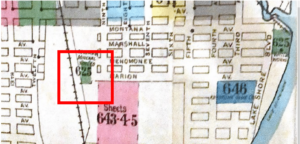 Sanborn fire maps were designed to assist fire insurance agents in determining the degree of hazard associated with a particular property. They were published by the Sanborn Map Co. The Columbia Mineral Wool Co. is boxed in red. It began operating here in 1892 as the Standard Mineral Wool Co. Interestingly, there were quite a few fires at the factory but they always rebuilt and continued to produce mineral wool insulation into the late 1950s.
Sanborn fire maps were designed to assist fire insurance agents in determining the degree of hazard associated with a particular property. They were published by the Sanborn Map Co. The Columbia Mineral Wool Co. is boxed in red. It began operating here in 1892 as the Standard Mineral Wool Co. Interestingly, there were quite a few fires at the factory but they always rebuilt and continued to produce mineral wool insulation into the late 1950s.
 Sanborn fire maps were designed to assist fire insurance agents in determining the degree of hazard associated with a particular property. They were published by the Sanborn Map Co. The Columbia Mineral Wool Co. is boxed in red. It began operating here in 1892 as the Standard Mineral Wool Co. Interestingly, there were quite a few fires at the factory but they always rebuilt and continued to produce mineral wool insulation into the late 1950s.
Sanborn fire maps were designed to assist fire insurance agents in determining the degree of hazard associated with a particular property. They were published by the Sanborn Map Co. The Columbia Mineral Wool Co. is boxed in red. It began operating here in 1892 as the Standard Mineral Wool Co. Interestingly, there were quite a few fires at the factory but they always rebuilt and continued to produce mineral wool insulation into the late 1950s.Sally’s Candy Cupboard—Elaine M Zembrzuski Becker
I recently read an article by Sue Ziarek in the SM Historical Society newsletter. The topic of Sally’s candy store is near and dear to my heart and memory. Sally’s ranked right up there with Mrs. Barth’s candy store on Rawson Ave. (As a child, my 15 cents went a lot further at Barth’s) My olfactory memories of Sally’s are very strong. As a little girl, I sometimes stood outside the busy store while my father squeezed in line with the other holiday shoppers—Christmas and Easter. But my favorite memory of Sally’s was as a little kid during Barn Storming. My Dad walked with my sisters and I, from 18th Ave, through the parkway, past St. Adalbert’s, and over to Milwaukee Ave. Every school and church we passed were housing marching band members from all around the country. It was the evening before the Spectacle of Music and the city was truly “a buzz”. We walked from one end of Milwaukee Ave. to the other, greeting people we knew from school, church, neighbors, relatives and those friends of my Dad’s that worked at Kyle. The co-workers were particularly interesting to us kids who had never laid eyes on these men who worked daily with our father. Almost every store was open long beyond the usual closing hour. But the only store we actually went into was Sally’s candy store at the far end of Milwaukee Ave. My Dad brought us all inside to pick a sucker. The blue were root beer, red cinnamon, and green were spearmint. They were opaque with an almost foam like texture. And then we walked all the way back down Milwaukee Ave toward our house. My sticky sucker had to be fully consumed before my father would heed my complaints of sore feet and pick me up onto his shoulders for the remainder of the journey. It was well worth the walk to get to Sally’s.
Sally’s Candy Cupboard from Mike Rudolf
Mike Rudolf shared a memory from his childhood. Even though they lived in St. Francis his father did his banking at the old Home State Bank in SM because they offered free checking. Sometimes Mike would come with him on Friday morning when he cashed his pay check and they’d go to Sally’s afterwards for 25 cent chocolate chip ice cream in a waffle cone.
More to come!